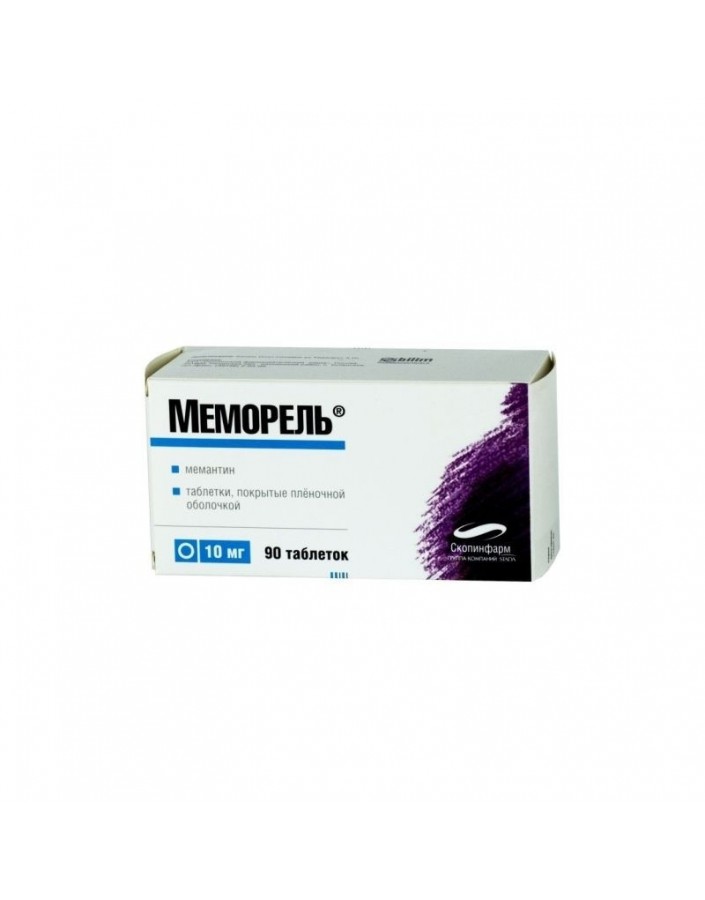




Security policy (edit with Customer reassurance module)

Delivery policy (edit with Customer reassurance module)

Return policy (edit with Customer reassurance module)
1 coated pill contains:
Memantine hydrochloride 10 mg.
Lactose monohydrate 192.5 mg, microcrystalline siliconized cellulose (microcrystalline cellulose 36.75 mg, colloidal silicon dioxide 0.75 mg) 37.50 mg, talc 2.50 mg, Magnesium stearate 2.50 mg.
Opadry 0Y-S-28959 (white): hypromellose (hydroxypropyl methylcellulose) 3.1250 mg, titanium dioxide 1.5625 mg triacetin 0.3125 mg.
In the blister of 10 tablets. In a carton of 9 blisters.
Indications for use
Dementia moderate to severe in Alzheimer's disease.
Pharmacokinetics:
After oral administration, Memantine is rapidly and completely absorbed from the gastrointestinal tract. C max is achieved within 2-6 hours
In normal renal function, cumulation of memantine is not observed.
Elimination takes place in two phases. T 1/2 it averages 4–9 h in the first phase, and 40–65 h in the second phase. It is mainly excreted by the kidneys (75–90%).
It has nootropic, cerebrovasodilating, antihypoxic and psychostimulating action.
Adamantane derivative, by chemical structure and pharmacological properties similar to amantadine.It blocks glutamate N-methyl-O-aspartate receptors (including in the black substance), thereby reducing the excessive stimulating effect of cortical glutamate neurons on neostriatum, which develops against the background of insufficient release of dopamine. Reducing the flow of ionized Calcium into neurons, reduces the possibility of their destruction. Mostly affects stiffness (rigidity and bradykinesia).
In addition to the action on the central nervous system, memantine affects efferent innervation. Improves weakened memory, concentration, reduces fatigue and symptoms of depression, reduces spasticity of skeletal muscles caused by diseases and injuries of the brain, increases daily activity.
Use during pregnancy and lactation
Memantine is contraindicated for use during pregnancy.
If necessary, the use of memantine during lactation should decide on the termination of breastfeeding.
Contraindications
Carefully:
Dizziness, headache, drowsiness, gait disturbance, confusion, hallucinations, convulsions,, anxiety.
Nausea, vomiting, constipation, pancreatitis.
With simultaneous use can weaken the effect of barbiturates and neuroleptics.
The action of Baclofen and dantrolene may change under the influence of memantine, therefore, it may be necessary to adjust their doses.
With simultaneous use of memantine with levodopa preparations, dopamine agonists, anticholinergic agents, the action of the latter can be enhanced.
Due to the fact that memantine and amantadine are NMDA receptor antagonists, simultaneous use should be avoided due to the risk of developing toxic effects.
Combinations of memantine with ceramic, dextromethorphan and phenytoin are also potentially toxic.
For the transport of amantadine, zimetidine, Ranitidine, quinidine, procainamide, quinine, and nicotine, the same renal cationic system is used in the body, which may cause the interaction of these drugs with memantine, leading to an increase in its plasma concentration.
With simultaneous use of memantine may cause a decrease in the concentration of hydrochlorothiazide in the serum.
With simultaneous use with Warfarin and other indirect anticoagulants require careful monitoring of prothrombin time and international normalized ratio.
Overdose
The drug should be taken orally, regardless of the meal.
The maximum daily dose of 20 mg per day.
Dose adjustment in elderly patients (over 65 years) is not required.
With moderate renal failure (creatinine clearance 50-80 ml / min), dose adjustment is usually not required.
With creatinine clearance of 30-49 ml / min, the daily dose initially does not exceed 10 mg, then after 7 days, provided the patient is well tolerated, the dose can be increased up to 20 mg.
In severe renal insufficiency (creatinine clearance 5-29 ml / min) the daily dose should not exceed 10 mg.
With mild and moderate liver failure (class A and B according to Child-Pugh classification), dose adjustment is not required.
With alkaline urine, more careful monitoring of these patients is required due to slower removal of memantine.
Care should be taken when driving and performing work that require high concentration of attention.
Store at a temperature not exceeding 25 ° C.